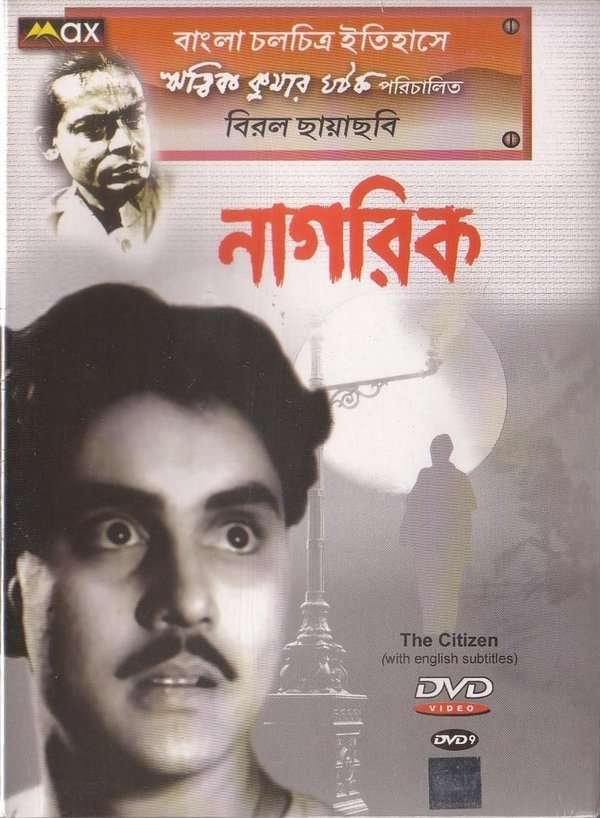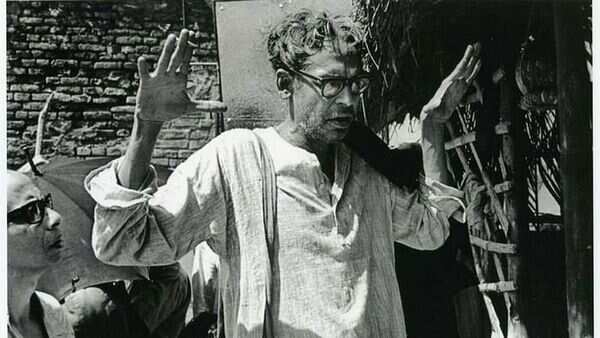- News
- entertainment
- bengali
- movies
- Remembering Ritwik Ghatak: A filmmaker’s fascination for the metaphorical language
Trending
This story is from February 6, 2021
Remembering Ritwik Ghatak: A filmmaker’s fascination for the metaphorical language
What distinguishes Ritwik Ghatak's works from his contemporaries? And more importantly what relevance do they hold today?

Ritwik Ghatak’s films still remain as one of the most powerful artistic articulations of the trauma of displacement after the Partition. He never accepted the Partition and it became an obsessive theme with him. His fascination for metaphors is also a testament to his brilliance.
‘Nagarik’ and ‘Bari Theke Paliye’, though disparate in themes, celebrate the rich and distinct oeuvre of Ritwik Ghatak, which even today continue to generate different interpretations.This is despite the fact that Ghatak made only eight feature films as opposed to the larger repertoire of films of his contemporaries, Satyajit Ray and Mrinal Sen.

So, what distinguishes Ritwik Ghatak's works from his contemporaries? And more importantly what relevance do they hold today?
Ghatak was one of the few artists who found catharsis through his works and harbored a love for metaphors. His fascination for the metaphorical language came from his deep understanding of Indian mythologies and epics. Interspersed with mythological allusions, he showed the plight of people affected by partition through heightened melodrama, while Satyajit Ray, his more popular contemporary, breathed subtlety into his films and Mrinal Sen, who also experienced the trauma of Bengal's partition, chose a direct approach to his films.
The justification of Ghatak's 'melodrama' approach can be found in American filmmaker Sidney Lumet’s interview with The New York Times. He had said, "In a well-written drama, the story comes out of the characters. The characters in a well-written melodrama come out of the story". For Ghatak, his works and creative nerve focused on the people who were devastated by the partition of Bengal. He was also one of them.

Metaphors submerged in melodrama
In his most acclaimed film ‘Meghe Dhaka Tara’, which deals with the exploitation of a daughter (the elder sister) by her family is a moving tale where Ghatak excels in using metaphorical language in a 'melodrama' format. In the film, the elder sister represents his motherland, which was divided into East and West Bengal. She accepts the role of sustaining the family. Her beloved represents those who love their motherland but desert her for greener pastures, while her younger sister and mother resemble vultures. Her elder brother who understands her plight and his own shirking of responsibilities epitomize those who wait for ideal conditions for the unification of their motherland. Her father, who understands these circumstances, symbolizes the ill-equipped and irresolute people who could not save their motherland from division. But his failure gnaws at his insides. The last statement from the daughter when she says, 'Brother I wanted to live!' is a strong protestation on her part (the motherland) for her division. These are incisive studies in people, who were forced to live in squalid conditions, and in their attempts to survive they lost love, values and kindness. It is in the sharing of such personal observations that Ghatak departed from his contemporaries.

The moralist element
Coincidence was a common device, which brought a moralistic element, in Ghatak's repertoire. For instance, the brothel scene in the film ‘Subarnarekha’. The sister (in Subarnarekha) confronting her estranged brother as her first client has enormous meaning. Since childhood, she yearns for a new home after she and her elder brother, Iswar Chakraborty, are rendered homeless due to partition. Here too, she is a 'motherland' figure who ends up in a brothel. Through the film, Ghatak shows how partition fails to present a new home for those who choose to stay on the other side of the Bengal. Ray and Sen are not known to use the 'coincidence' device.
The progressive approach
Apart from the partition, Ghatak captured many other themes that were more progressive than his contemporaries. His first feature film ‘Nagarik’ (1951) that was released after his death, dealt with unemployment in Bengal. It was years after ‘Nagarik’ that Ray made films like ‘Pratidwandi’ and ‘Jana Aranya’. Interestingly, even before French director Francois Truffaut explored the theme of a mischievous kid who runs away from his home in the 1959 film ‘The 400 Blows’, Ghatak made ‘Bari Thake Paliye’ on a similar theme in 1958.

Such artistic vision gave Ghatak a unique voice among his peers. Even Satyajit Ray in his introduction to the Ghatak book, ‘Cinema and I’, says, "Ritwik was one of the few truly original talents in the cinema this country has produced. As a creator of powerful images in an epic style he was virtually unsurpassed in Indian cinema".
The relevance of his characters
But why have his films endured over decades? It is perhaps in the justifications of the views and actions of most characters in his films. For instance, in ‘Subarnarekha’, Haraprasad accuses his friend Iswar Chakraborty of being a deserter because the latter abandoned his people to begin a new life. This may appear as dissension between an idealist and a pragmatic but both are right. Chakraborty, who suffers the horrors of Partition, has to raise a young sister. He believes that raising her (a low-caste child) singlehandedly, also counts as a contribution to the movement to support dislocated people. We can apply Ghatak's interpretation to contemporary politics.

Ghatak's most enchanting non-Partition film Ajantrik, which tells the story of a man's deep attachment to his taxi, is also very relevant today. The man builds a virtual world in which he communicates his emotions to his taxi and the machine, in return, also shows its affection and resentment. Today, when most people have immersed themselves in gadgets and social networking, this film reflects the tendency among people to weave a small virtual world around them, where human company is scarcely needed.
‘Nagarik’ and ‘Bari Theke Paliye’, though disparate in themes, celebrate the rich and distinct oeuvre of Ritwik Ghatak, which even today continue to generate different interpretations.This is despite the fact that Ghatak made only eight feature films as opposed to the larger repertoire of films of his contemporaries, Satyajit Ray and Mrinal Sen.

So, what distinguishes Ritwik Ghatak's works from his contemporaries? And more importantly what relevance do they hold today?
Obsessions with metaphors
Ghatak was one of the few artists who found catharsis through his works and harbored a love for metaphors. His fascination for the metaphorical language came from his deep understanding of Indian mythologies and epics. Interspersed with mythological allusions, he showed the plight of people affected by partition through heightened melodrama, while Satyajit Ray, his more popular contemporary, breathed subtlety into his films and Mrinal Sen, who also experienced the trauma of Bengal's partition, chose a direct approach to his films.
The justification of Ghatak's 'melodrama' approach can be found in American filmmaker Sidney Lumet’s interview with The New York Times. He had said, "In a well-written drama, the story comes out of the characters. The characters in a well-written melodrama come out of the story". For Ghatak, his works and creative nerve focused on the people who were devastated by the partition of Bengal. He was also one of them.

Metaphors submerged in melodrama
In his most acclaimed film ‘Meghe Dhaka Tara’, which deals with the exploitation of a daughter (the elder sister) by her family is a moving tale where Ghatak excels in using metaphorical language in a 'melodrama' format. In the film, the elder sister represents his motherland, which was divided into East and West Bengal. She accepts the role of sustaining the family. Her beloved represents those who love their motherland but desert her for greener pastures, while her younger sister and mother resemble vultures. Her elder brother who understands her plight and his own shirking of responsibilities epitomize those who wait for ideal conditions for the unification of their motherland. Her father, who understands these circumstances, symbolizes the ill-equipped and irresolute people who could not save their motherland from division. But his failure gnaws at his insides. The last statement from the daughter when she says, 'Brother I wanted to live!' is a strong protestation on her part (the motherland) for her division. These are incisive studies in people, who were forced to live in squalid conditions, and in their attempts to survive they lost love, values and kindness. It is in the sharing of such personal observations that Ghatak departed from his contemporaries.

The moralist element
Coincidence was a common device, which brought a moralistic element, in Ghatak's repertoire. For instance, the brothel scene in the film ‘Subarnarekha’. The sister (in Subarnarekha) confronting her estranged brother as her first client has enormous meaning. Since childhood, she yearns for a new home after she and her elder brother, Iswar Chakraborty, are rendered homeless due to partition. Here too, she is a 'motherland' figure who ends up in a brothel. Through the film, Ghatak shows how partition fails to present a new home for those who choose to stay on the other side of the Bengal. Ray and Sen are not known to use the 'coincidence' device.
The progressive approach
Apart from the partition, Ghatak captured many other themes that were more progressive than his contemporaries. His first feature film ‘Nagarik’ (1951) that was released after his death, dealt with unemployment in Bengal. It was years after ‘Nagarik’ that Ray made films like ‘Pratidwandi’ and ‘Jana Aranya’. Interestingly, even before French director Francois Truffaut explored the theme of a mischievous kid who runs away from his home in the 1959 film ‘The 400 Blows’, Ghatak made ‘Bari Thake Paliye’ on a similar theme in 1958.

Such artistic vision gave Ghatak a unique voice among his peers. Even Satyajit Ray in his introduction to the Ghatak book, ‘Cinema and I’, says, "Ritwik was one of the few truly original talents in the cinema this country has produced. As a creator of powerful images in an epic style he was virtually unsurpassed in Indian cinema".
The relevance of his characters
But why have his films endured over decades? It is perhaps in the justifications of the views and actions of most characters in his films. For instance, in ‘Subarnarekha’, Haraprasad accuses his friend Iswar Chakraborty of being a deserter because the latter abandoned his people to begin a new life. This may appear as dissension between an idealist and a pragmatic but both are right. Chakraborty, who suffers the horrors of Partition, has to raise a young sister. He believes that raising her (a low-caste child) singlehandedly, also counts as a contribution to the movement to support dislocated people. We can apply Ghatak's interpretation to contemporary politics.

Ghatak's most enchanting non-Partition film Ajantrik, which tells the story of a man's deep attachment to his taxi, is also very relevant today. The man builds a virtual world in which he communicates his emotions to his taxi and the machine, in return, also shows its affection and resentment. Today, when most people have immersed themselves in gadgets and social networking, this film reflects the tendency among people to weave a small virtual world around them, where human company is scarcely needed.
End of Article
FOLLOW US ON SOCIAL MEDIA








